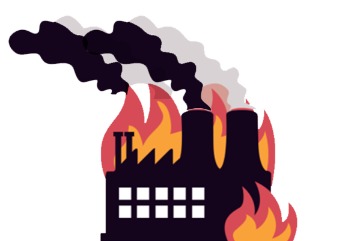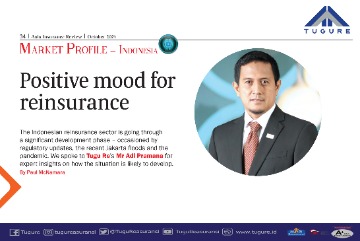- Home
- News & Media
- Detail
The term "reinsurance" is not commonly heard by the general public. This term is used when an insurance company protects itself against insurance risks by utilizing the services of another insurance company.
The term "re" itself actually refers to the meaning of "to be able to share the risk it faces by reinsuring a portion of that value with another company (reinsurance company)."
So why do insurance companies feel the need to engage in reinsurance?
The first reason is to share or spread the risk. They may feel that the value of the insurance premium they are taking on is greater than the value they can bear.
All of this is done because companies fundamentally want to protect the stability of their income, and reinsurance protects them from potential significant losses.
In other words, to gain profit as an intermediary, insurance companies reinsure with reinsurance companies at a lower premium rate than what they charge their own clients.
Almost all reinsurance involves more than one reinsurance company, which is related to risk distribution. The reinsurance company that determines the contract conditions and reinsurance premiums is called the lead insurer, while other reinsurance companies participating in the contract are called following reinsurers.
Reinsurance is divided into two main types: proportional reinsurance and non-proportional reinsurance.
Proportional reinsurance is when the reinsurer takes over the claims risk proportionally based on the claims. For example, if there is a proportional reinsurance agreement between an insurance company and a reinsurance company for 30%, if a claim is made by a policyholder, the insurance company only needs to pay 70% of the claim amount, while the remaining 30% of the claim will be covered by the reinsurance company.
On the other hand, non-proportional reinsurance is when the reinsurance company covers claims above a maximum limit that it can bear. For example, if an insurance company and a reinsurance company have an agreement to cover claims above a limit of two billion, and there is a claim of 1.2 billion, the insurance company will cover the entire claim. However, if there is a claim of 2.5 billion, the insurance company will only cover according to the agreement, for example, 500 thousand, and the remainder will be covered by the reinsurance company.
So there you have it. Reinsurance products ensure that you don't have to worry about the guarantee of protection you receive after obtaining insurance, even for the most significant risks.

Secara garis besar, asuransi adalah pertanggungan atau perjanjian antara dua belah pihak... Read More

Salam Tugurean ....
Artikel bulan ini membahas mengenai Management Penyimpanan Gudang, untuk menghindari da... Read More

Salam Tugurean ....
Artikel bulan ini membahas mengenai Management Mengurangi Resiko pada Pabrik Plastik, Read More

Salam Tugurean ....
Artikel bulan ini membahas mengenai penyebab terjadinya kebakaran hutan dan seperti apa... Read More
Salam Tugure ....
Artikel bulan ini membahas mengenai Dampak Banjir dan Bagaimana Mencegah dan Menangg... Read More
Salam Tugure, kami hadir untuk memberikan informasi kepada anda. Maraknya pencurian masih menjadi teror bagi kita sem... Read More
Salam Tugure, kami hadir untuk memberikan informasi kepada anda. Maraknya bencana alam di indonesia, diawal tahun 202... Read More
Informasi Tugure Perihal WFH - Work From Home
... Read MoreInformasi Tugure Perihal HUT Ke 33 PT Tugu Reasuransi Indonesia.
... Read More
Salam Tugure, kami hadir untuk memberikan informasi kepada anda. Dalam Pandemi Covid-19 ini bagaimana cara survei ris... Read More
Information The Correspondence and Administrative
... Read MoreTugure Torehkan Peningkatan Hasil Usaha
... Read More
TUGURE Sharing Knowledge Edisi Sekarang Membahas Mengenai, Jarak Bangunan Kita Terhadap Potensi Kebakaran.
... Read More
Asia Insurance Review - October 2021
The Indonesian reinsurance sector is going through a sign... Read More


Health is the most important part that must be maintained. In addition to maintaining a healthy lifestyle, you should... Read More

Protecting private vehicles with vehicle insurance has become a basic need for some people. How not, the risk of driv... Read More

Education Insurance is a well-known insurance product with very useful benefits for your child's future. Educatio... Read More

Home insurance is insurance that provides protection against losses resulting from fire, theft, or damage caused by n... Read More

Holiday moments with friends, spouse or family are the most enjoyable moments. But, don't let that moment be disr... Read More

Have you ever heard of the term Reinsurance? Reinsurance is a term used by a company/business entity to protect it ag... Read More

The target o... Read More

Interested i... Read More

Not only doe... Read More

Before deciding to choose the type of insurance is to understand the terms in the insurance policy. One term that is ... Read More

Having a vehicle such as a car should be able to protect it with insurance. Car Insurance itself provides protection ... Read More

Performing t... Read More

Choosing an ... Read More

Entering pro... Read More

Even though they have similar benefits, Life Insurance and Health Insurance still have differences too. Like what? Read More

The solution to releasing fatigue by taking a vacation or traveling to a new place is the most powerful weapon for re... Read More

Although retirement is still relatively long. However, it should still be prepared as early as possible. Why?
... Read More
Home is a most valuable asset. To get it we have to work hard and save a lot of time.
Like a very valuable ... Read More

Purchasing car insurance requires careful consideration. Should you choose Total Loss Only (TLO) insurance or compreh... Read More

Who doesn't love to travel? Going on a trip is a great way to relieve stress and take a break from our daily acti... Read More

Just like other insurance products, choosing home insurance requires careful consideration.
Currently, ther... Read More

Life insurance provides financial protection against unexpected risks such as death, accidents, critical illness, and... Read More

Choosing an insurance company can be challenging. With so many companies claiming to be the best, it's important ... Read More

The term "reinsurance" is not commonly heard by the general public. This term is used when an insurance com... Read More

Being a career woman comes with double responsibilities. However, it is not surprising, especially in big cities, to ... Read More

Enjoying your retirement requires preparation starting from your productive years. The only thing you can rely on dur... Read More

Choosing an insurance product is not something to be taken lightly, especially for women. It requires careful conside... Read More

In order to meet the expenses of your child's education, it is important to prepare for it as best as possible, e... Read More

Unit Link insurance has become popular in Indonesia, with claimed benefits that can be highly advantageous for consum... Read More

To All Business Partners of PT Tugu Reasuransi Indonesia, we kindly request your assistance in improving our service ... Read More
Innalilahi wainalilahi rojiun
It is with deep sorrow that we announce the passing of
Mr. Usmanshah

Dear Tugure Business Partners,
We would like to inform you that the official email domain of PT Tugu Reasur... Read More